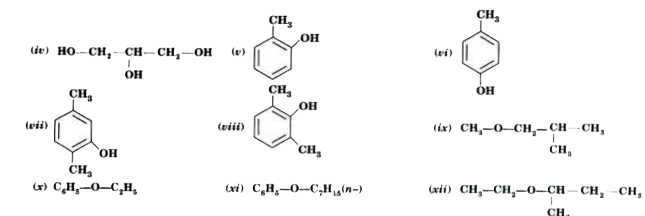CH3CH∣CH3−CH=CH2(i)B2H4−−−−−−−−−→(ii)H2O2/OHXH2SO4−−−→140∘Y
What is Y ?
CH3−CH∣CH3−CH2−CH2−O−CH2−CH2−CH∣CH3−CH3
CH3−CH∣CH3−CH=CH2
CH3−CH∣CH3−CH∣CH3−O−CH∣CH3−CH∣CH3−CH3
CH3−CH3∣C∣C2H5−O−CH3∣C∣C2H5−CH3
The correct Answer is:A
To solve the given problem, let's break down the steps involved in the reaction sequence:
Step 1: Identify the Starting Compound
The starting compound is an alkene:
CH3CH(CH3)CH=CH2
Step 2: Reaction with B2H6
The first reaction involves the addition of diborane (B2H6) to the alkene. According to the anti-Markovnikov rule, the boron atom will attach to the less substituted carbon atom of the alkene, resulting in the formation of a trialkyl borane.
The product after this step (let's call it X) will be:
CH3CH(CH3)CH2B(OH)2
Step 3: Oxidation with H2O2 and OH-
Next, we treat the trialkyl borane with hydrogen peroxide (H2O2) in the presence of hydroxide ions (OH-). This will lead to the oxidation of the boron compound to form an alcohol.
The resulting alcohol (X) will be:
CH3CH(CH3)CH2OH
Step 4: Reaction with Concentrated H2SO4
Now, we will react the alcohol (X) with concentrated sulfuric acid (H2SO4) at a temperature of 140°C. This reaction will favor elimination due to the high temperature, leading to the formation of an ether.
Step 5: Formation of Ether (Y)
The elimination reaction will result in the formation of an ether. The structure of the ether (Y) will be:
CH3CH(CH3)CH2OCH2CH2CH(CH3)
Final Answer
Thus, the final product Y is:
CH3CH(CH3)CH2OCH2CH2CH(CH3)
The starting compound is an alkene:
CH3CH(CH3)CH=CH2
The first reaction involves the addition of diborane (B2H6) to the alkene. According to the anti-Markovnikov rule, the boron atom will attach to the less substituted carbon atom of the alkene, resulting in the formation of a trialkyl borane.
CH3CH(CH3)CH2B(OH)2
Next, we treat the trialkyl borane with hydrogen peroxide (H2O2) in the presence of hydroxide ions (OH-). This will lead to the oxidation of the boron compound to form an alcohol.
CH3CH(CH3)CH2OH
Now, we will react the alcohol (X) with concentrated sulfuric acid (H2SO4) at a temperature of 140°C. This reaction will favor elimination due to the high temperature, leading to the formation of an ether.
The elimination reaction will result in the formation of an ether. The structure of the ether (Y) will be:
CH3CH(CH3)CH2OCH2CH2CH(CH3)
Thus, the final product Y is:
CH3CH(CH3)CH2OCH2CH2CH(CH3)
Topper's Solved these Questions
- ALCOHOLS, PHENOLS AND ETHERSBOOK - AAKASH INSTITUTECHAPTER - ALCOHOLS, PHENOLS AND ETHERSEXERCISE - Assignment Section - C (Previous Years questions)
25 Videos
- ALCOHOLS, PHENOLS AND ETHERSBOOK - AAKASH INSTITUTECHAPTER - ALCOHOLS, PHENOLS AND ETHERSEXERCISE - Assignment Section - C (Questions asked Prior to medical Ent. Exams. 2005)
13 Videos
- ALCOHOLS, PHENOLS AND ETHERSBOOK - AAKASH INSTITUTECHAPTER - ALCOHOLS, PHENOLS AND ETHERSEXERCISE - Assignment Section - A (Objective type questions)
45 Videos
- ALCOHOLS, PHENOLS AND ETHERS BOOK - AAKASH INSTITUTECHAPTER - ALCOHOLS, PHENOLS AND ETHERS EXERCISE - Try Yourself
5 Videos
Similar Questions
(A)Al2O3−−−−−→523K(B)(ii)HI−−−−−−→(i)AgOH(C)Al2O3−−−−−→423K(B)(i)B2H6−−−−−−−−−−−→(ii)H2O2,OH−(A)
In the above reactions scheme (A) and (C ) are isomers. (B) has a fomula of C5H10 , which can also be obtained from the product of the reactions ofCH3CH2MgBrCO. GIve structures of (A),(B) and (C).
So, CH3−CH3∣CH−C∣OHH−CH3(A)Al2O3−−−−−→523KCH3−CH3∣C=CH−CH3(B)C5H10(i)HI−−−−−−−→(ii)AgOHCH3−CH3∣C∣OH−CH2CH3(C)Al2O3−−−−−−−−−−→423K,(−H2O)CH3−CH3∣C=CHCH3(B)(i)B2H6−−−−−−−−−−−→(ii)H2O2,OH−CH3−CH3∣CH−C∣OHH−CH3
View SolutionWrite IUPAC names of the following compounds :
(i) CH3−CH∣CH3−CH2−CH∣OH−CH3∣C∣CH3−CH3 (ii) H3−C−CH∣OH−CH2−CH∣OH−CH∣C2H5−CH2−CH3
CH3−CH∣OH−CH∣OH−CH3
(iv) HO−CH2−CH∣OH−CH2−OH

View Solution
Knowledge Check
CH3CH∣CH3−CH=CH2(i)B2H4−−−−−−−−−→(ii)H2O2/OHXH2SO4−−−→140∘Y
What is Y ?ACH3−CH| CH3−CH2−CH2−O−CH2−CH2−CH| CH3−CH3BCH3−CH| CH3−CH=CH2CCH3−CH| CH3−CH| CH3−O−CH| CH3−CH3DCH3−CH3| C | C2H5−O−CH3| C | C2H5−CH3CH3CH2CH=CH2B2H→ZH2O.H2O2.
What is Z?ACH3CH2C∣OHHCH3BCH3CH2CH2CHOCCH3CH2CH2CH3DCH3CH2CH2CH2OHCH3CH2CH=CH2B2H6−−−−−−−−−−→H2O.H2O2.OH−Z
What is Z?ACH3CH2C∣OHHCH3BCH3CH2CH2CHOCCH3CH2CH2CH3DCH3CH2CH2CH2OH
The correct IUPAC name of the following compound is :
CH3CH2−C∣CH3H−CH=C∣C2H5−C2H5∣CH−CH2−CH2−CH2−CH3
View SolutionName the following compounds accoring to IUPAC system :
(i) CH3−CH2−CH∣CH2Cl−CH2OH∣CH−CH∣CH3−CH3(ii)CH3−CH∣CH3−CH2−CH∣OH−CH2OH∣CH−CH3
(iii) (iv) H2C=CH−CH∣OH−CH2−CH2−CH3
(iv) H2C=CH−CH∣OH−CH2−CH2−CH3
(v) CH3−C∣CH3=C∣Br−CH2OH
View SolutionCH3CH2−CH3∣C∣CH3−C∣OHH−CH3H2SO4−−−→heatPMajor
What is the major product P in the above reactions?
View SolutionCH3CH2CH2OHconc. H2SO4−−−−−−−−→170∘CACl2−−−→500∘CB.
A and B. are
View SolutionCH3−CH3∣CH−NO2NaNO2+H2SO4−−−−−−−−−−−−→at0∘C(A). (A) is:
View Solution
